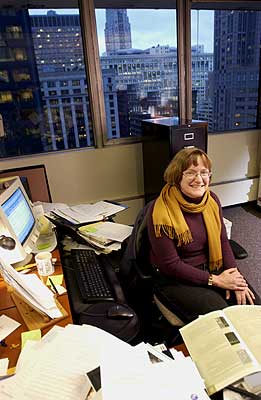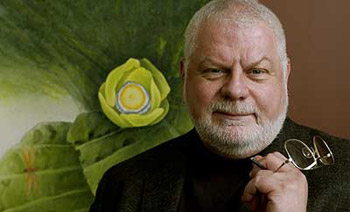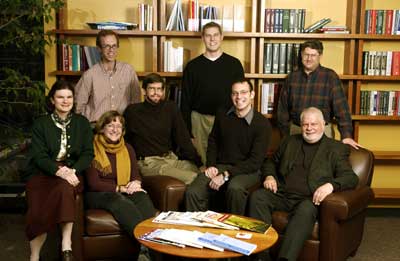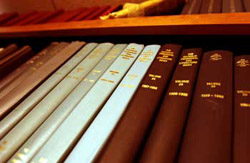 From
an office in Chicago’s
Loop, a group of U of C alumni compiles
the world’s largest index of religious journals and book
reviews.
From
an office in Chicago’s
Loop, a group of U of C alumni compiles
the world’s largest index of religious journals and book
reviews.
New journals are
always piling up on Heidi Arnold’s sunny, window-side
desk in the penthouse quarters of the American Theological
Library Association (ATLA), located in a Chicago Loop office
building just across the street from the Sears
Tower. Some are
solicited, as when Arnold,
AM’93, the acquisitions manager of the ATLA index department,
or one of her colleagues hears of an interesting publication
at a conference and requests a copy. Other journals are
forwarded by a marketing manager or publisher. A few journals
arrive via the Internet—the Journal of Southern Religion,
Hugoye: Journal of Syriac Studies, the Journal of Buddhist
Ethics. Though Arnold
never clears her desk entirely, she keeps the journals in
motion, circulating them up and down the index department’s
neat row of cubicles to determine if they should be included
in the ATLA Religion Database, or RDB—the biggest of the
ATLA indexes and the world’s largest index of religious
journal articles and book reviews.
 |
|
The route from publication
to inclusion in the religion Database begins on the
desk of Heidi Arnold (above), and ends a few months
later when Cameron Campbell, AM'84 (below, right), signs
off on the index's latest edition.
|
|
Back in 1949 a trio of theological librarians
at the then-three-year-old ATLA began indexing contemporary
scholarly periodicals on Protestant theology. They focused
on what they considered important: journals and books of
essays on Old Testament and New Testament studies and heavy
doses of church history. The size of the index department
has since increased (to a current 11), and so has the scope
of its work, which now covers world religions as well as
the history and sociology of religion. Meanwhile the ATLA
has grown to an 800-member professional association serving
theological and religious-studies librarians, and the Religion
Database, once published the old-fashioned way as disparate,
bulky paper indexes, has entered the Internet age. At last
count its online database contained more than 1.2 million
records.
While Chicago grads work in many capacities
at the ATLA—microfilming fragile materials, writing programs
for information services, and selling ATLA products—they
are represented most strongly in the index department, the
largest in the 37-employee organization. All but one member
of the group has studied at Chicago,
where they immersed themselves in 17th-century English devotional
literature, the Old Testament, and Syro-Palestinian archaeology.
They took courses in the Divinity
School, the comparative-literature
department, and the erstwhile Graduate
Library School.
Some are still taking classes or writing dissertations.
Quite a few worked at the Regenstein Library, including
Cameron J. Campbell, AM’84, who until two years ago was
the Reg’s head of serials and digital-resources cataloging
and now heads the ATLA index department.
“It’s not that hard to figure out why
so many of us hail from the U of C,” says indexer Steven
Holloway, AM’83, PhD’92, who began working part time at
the ATLA as a “hungry graduate student” in 1988, when indexing
took place in offices near 57th and University (the indexers
then moved to quarters in Evanston, and in September 2000
the ATLA moved into its downtown digs). After all, ATLA
indexers are not only “obsessive-compulsive,” as Holloway
jokes, but they also are intelligent and read many languages—able
to digest the latest editions of Kabbalah, Svensk
Missionstidskrift, and the Bulletin of the American
Society of Papyrologists, quickly assigning each article
a trio or so of descriptive subject headings: “Waco Branch
Davidians Disaster, Tex, 1993,” for example, or “Bible (OT)—Genesis
1–11.” And this outpost of Chicago
grads wields a certain power. While they don’t determine
the canon of religious scholarship, their work inevitably
helps shape it.
The Religion Database
works much like the Readers’ Guide to Periodical
Literature, the first index that many students learn to
use, with journal articles, essays, or book reviews (and
the publications in which they appear) listed under multiple
subject headings.
The RDB indexers currently sift the contents
of approximately 700 journal titles. While the purpose of
the indexing—to simplify the search for relevant material
in the vast amount of literature out there—hasn’t changed
much since 1949, the technology has. CD-ROM technology was
introduced into reference publishing in the late 1980s and
early 1990s. Then came the aggregators—online subscription
services, such as First Search and Silver Platter, that
distribute multiple databases covering a variety of subjects.
In the span of a decade, the potential reach of tools like
the ATLA’s four print indexes was vastly extended, points
out executive director Dennis Norlin, and in 1995 the association
created a new product—the Religion Database—that would combine
records from the existing indexes, one each devoted to periodicals,
multi-author works, book reviews, and research in ministry.
 Sales
of the RDB ($2,300–$2,500 each, depending on the format
and purchaser) have risen from 859 in 2000 to 1,063 this
year. The greatest increase came in subscriptions purchased
through online aggregators, while CD-ROM sales saw the greatest
drop, according to sales manager Rick Adamek, SM’77, who
has also worked in the ATLA preservation department and
on the book review index. Of course, says Norlin, it will
be a long time before the association’s print and CD-ROM
products disappear. In libraries he’s visited in Cuba
and Africa that are strapped for
resources, “CD-ROM is about all they can handle right now.”
Sales
of the RDB ($2,300–$2,500 each, depending on the format
and purchaser) have risen from 859 in 2000 to 1,063 this
year. The greatest increase came in subscriptions purchased
through online aggregators, while CD-ROM sales saw the greatest
drop, according to sales manager Rick Adamek, SM’77, who
has also worked in the ATLA preservation department and
on the book review index. Of course, says Norlin, it will
be a long time before the association’s print and CD-ROM
products disappear. In libraries he’s visited in Cuba
and Africa that are strapped for
resources, “CD-ROM is about all they can handle right now.”
But for those who can access the online
version, the benefits are obvious. One scholar at a small
institution in the Dakotas called
the RDB a “godsend” for those in remote locations. It’s
also simplified the logistics of research. Carolyn Coates,
AM’87, a former editor of the Religion Index One, the periodicals
subset of the RDB, points out how easy it is to switch from,
say, Humanities Index to Sociological Abstracts while planted
at a computer terminal. “It used to be you’d have to go
up and down the stairs to do that,” says Coates (who left
the ATLA this fall for an academic library post in Connecticut),
recalling her years at the Reg studying the history of religion
and Japanese religions. Juggling a dozen or so print volumes
of an index also was “very cumbersome.”
And print publishing, says Lowell Handy,
AM’80, PhD’87, a 14-year ATLA veteran who has taught New
Testament, Old Testament, and Introduction to the Bible
at Loyola University,
has its limits. “There’s a point at which bindings simply
break,” he says. But not so in cyberspace—at least in theory.
“The container does tend to shape the contained,” observes
department director Campbell,
speaking in Zenlike phrases that reflect his indexing of
journals on Buddhist practice and philosophy. “Suddenly
things became possible that were not possible before.”
As technology has evolved, so has the
widely diverse population using the RDB: scholars, church
officials, and seminary students, all with different needs.
As it stands the database emphasizes Bible studies and theology
more than the indexing staff would like, inadvertently shortchanging
fields like the sociology and anthropology of religion,
reflecting those fields’ relatively recent academic vogue
and the database’s own roots.
There’s an extent to which inclusion
in the database is by necessity “haphazard,” according to
Coates, who jokingly suggests that all canons are formed
“in fits and starts.” A past editor may have decided to
index a journal because it was deemed unusual rather than
scholarly, and for consistency that editor’s successor continued
the task rather than create holes in coverage. If a journal
has degraded significantly or its emphasis shifted, making
it more appropriately indexed elsewhere, the indexers would
discontinue coverage, but this hasn’t happened in recent
memory.
In their own shaping of the RDB, today’s
department members would like to increase the number of
third-world journals (currently 51) and branch out from
the database’s Western bent. Certain areas are neglected
entirely: all the material on Islam comes from Western-language
publications, rendering sources in Arabic “opaque” to RDB
users. Thus high on Campbell’s
wish list is an indexer fluent in modern Hebrew and Arabic.
 |
Nina
Schmit, AM'97; Arnold; Steven Holloway, AM'83, PhD'92;
Todd Ferry, AM'01; Campbell; standing: Gregg Taylor,
ABD; Kurt Buhring, AM'98; Lowell Handy, AM'80, PhD'87. |
This September the ATLA began a retrospective
indexing project, working to bring pre-1949 scholarship
into the database. In part, the project is a response to
changes in how students and faculty conduct research—according
to a recent study by Outsell for the Digital Library Federation,
for example, almost 90 percent of researchers begin online.
Indexers at the ATLA have anecdotes to back up the quantitative
data.
Steven Holloway recalls a conversation
with one seminary librarian shortly after that library first
received the RDB on CD-ROM in the early 1990s. Rather than
explore the extensive bibliography for Biblical studies,
Elenchus of Biblica, or the annual index of Zeitschrift
für die Alttestamentliche Wissenschaft, both of which
Holloway terms “superb surveys in print,” the librarian
reported that seminary students fawned over an electronic
function of the CD called the “scripture browse wheel,”
which enabled them to look up hits on particular scriptural
passages relatively easily.
Although he admits it could be coincidence,
Handy says he’s followed the careers of a few scholars who
only cite sources indexed in the RDB. And at the ATLA booth
at annual American
Academy of Religion–Society
of Biblical Literature conventions, he’s talked to scholars
who say the RDB is the only research tool they use.
“There’s a modern fetish to rely upon
scholarly works published in the last 50—or even 25—years,”
Holloway says. But in his personal browsing of 19th-century
journals, he’s found “phenomenal things,” citing evolving
interpretations of a particular Assyrian palace excavated
by the French in the 19th century as an esoteric but fascinating
story that unfolded over years’ worth of old journals.
Even if cyberspace
has room for an infinite number of database records,
Campbell asks,
is that what ATLA indexers should aspire to provide? There’s
a scholarly standard to be maintained: the department would
be loath to index what Handy terms “mom-and-pop-in-the-kitchen
newsletters,” even if the indexers had all the resources
in the world.
But there are limited resources. On average,
creating and finishing each indexing record costs $7–$8
in salaries and benefits, according to Campbell.
Adding more journals than the indexers can process in a
timely manner, he points out, would undermine the currency
of the semiannual listing, producing too big a gap between
a journal’s publication and its inclusion in the index.
Then there are the limitations of existing information systems.
Neither the RDB nor most library computer terminals, for
example, can handle the Cyrillic alphabet.
The department’s logistical limitations
can have a very real impact on publishers submitting journals.
Many libraries, Campbell
says, determine their acquisitions based on what’s covered
in the database, which is updated semiannually (possibly
quarterly in the next fiscal year). For a small publisher—and
some 80 percent of the indexed journals, acquisitions manager
Arnold notes, come from single-title publishers—inclusion
can mean a significant increase in subscriptions. And for
the past 18 months the association’s new ATLAS project has
brought online the full text of the articles in approximately
60 journals indexed in the RDB, affording those particular
journals still further attention.
 And
so the hopeful submissions continue to come in. Two recent
journals to cross Arnold’s
overflowing desk for possible RDB inclusion were Medieval
Philosophy and Theology, from Cambridge University
Press, and Old Testament Essays, the only journal
published by the Old Testament Society of South Africa.
Each indexer read several issues of the two publications,
and their recommendations were tallied. It can take six
months to a year to determine what to do with a journal:
accept it for indexing, put it on a wait list, or decide
it’s not right for the database. In each of the past five
years, the indexers have added an average of 18 titles,
primarily academic, peer-reviewed journals with established
publishing records. Most publishers are “only too happy,”
says Campbell,
to grant the ATLA complimentary subscriptions.
And
so the hopeful submissions continue to come in. Two recent
journals to cross Arnold’s
overflowing desk for possible RDB inclusion were Medieval
Philosophy and Theology, from Cambridge University
Press, and Old Testament Essays, the only journal
published by the Old Testament Society of South Africa.
Each indexer read several issues of the two publications,
and their recommendations were tallied. It can take six
months to a year to determine what to do with a journal:
accept it for indexing, put it on a wait list, or decide
it’s not right for the database. In each of the past five
years, the indexers have added an average of 18 titles,
primarily academic, peer-reviewed journals with established
publishing records. Most publishers are “only too happy,”
says Campbell,
to grant the ATLA complimentary subscriptions.
In the end the indexers decided to include
the full run of Medieval Philosophy and Theology
(which dates to 1991) and to put Old Testament Essays
on the wait list until they have the resources to index
it. The wait list, currently numbering 34, will continue
to grow, and in the meantime, the Essays editor has written
to Arnold that
he will “hope and pray” for its inclusion.
Realizing that their decisions are the
stuff of prayers, the ATLA indexers feel a responsibility
to use their resources wisely. “With a very small staff
we do a lot,” says Campbell.
“This is not the miracle of the loaves and the fishes.”
Julie Englander lives in Chicago,
where she works on documentary and other nonfiction television
projects.


![]() Contact
Contact
![]() About
the Magazine
About
the Magazine ![]() Alumni
Gateway
Alumni
Gateway ![]() Alumni
Directory
Alumni
Directory ![]() UChicago
UChicago![]() ©2002 The University
of Chicago® Magazine
©2002 The University
of Chicago® Magazine ![]() 5801 South Ellis Ave., Chicago, IL 60637
5801 South Ellis Ave., Chicago, IL 60637![]() fax: 773/702-0495
fax: 773/702-0495 ![]() uchicago-magazine@uchicago.edu
uchicago-magazine@uchicago.edu

 Sales
of the RDB ($2,300–$2,500 each, depending on the format
and purchaser) have risen from 859 in 2000 to 1,063 this
year. The greatest increase came in subscriptions purchased
through online aggregators, while CD-ROM sales saw the greatest
drop, according to sales manager Rick Adamek, SM’77, who
has also worked in the ATLA preservation department and
on the book review index. Of course, says Norlin, it will
be a long time before the association’s print and CD-ROM
products disappear. In libraries he’s visited in
Sales
of the RDB ($2,300–$2,500 each, depending on the format
and purchaser) have risen from 859 in 2000 to 1,063 this
year. The greatest increase came in subscriptions purchased
through online aggregators, while CD-ROM sales saw the greatest
drop, according to sales manager Rick Adamek, SM’77, who
has also worked in the ATLA preservation department and
on the book review index. Of course, says Norlin, it will
be a long time before the association’s print and CD-ROM
products disappear. In libraries he’s visited in 
 And
so the hopeful submissions continue to come in. Two recent
journals to cross
And
so the hopeful submissions continue to come in. Two recent
journals to cross